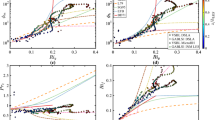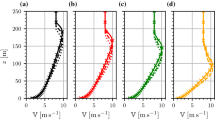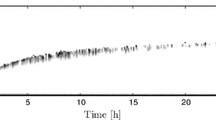Abstract
Numerical results indicate that advection of momentum in the boundary layer may significantly alter both the structure of the planetary boundary layer and its influence on the overlying free atmosphere. However, due to the nonlinearity of the inertial terms, it is always difficult to obtain the analytical solution of the boundary-layer model that retains the flow acceleration. In order to overcome this difficulty, the geostrophic momentum (hereafter GM) approximation has been introduced into boundary-layer models. By replacing the advected momentum with the geostrophic wind, the effect of the flow acceleration is partially considered and the original nonlinear partial differential equation set is converted to ordinary differential equations, the solutions of which can be obtained easily with standard techniques. However, the model employing GM fails to capture the features of the boundary layer when the spatio-temporal variation of the boundary-layer flow cannot be properly approximated by the geostrophic wind. In the present work, a modified boundary-layer model with the inertial acceleration in a different approximate form is proposed, in which the advecting wind instead of the advected momentum is approximated by the geostrophic wind (hereafter GAM).
Comparing the horizontal velocity and boundary-layer pumping obtained from the classical Ekman theory, and the model incorporating (i) GM and (ii) GAM, it is found that the model with GAM describes most facets of the steady well-mixed layer beneath a north-westerly flow with embedded mesoscale perturbations that is considered in the present work. Inspection of the solution of the model with GAM shows that, within the limit of the validation of the model (i.e., the Rossby number R O is not very large and the drag coefficient C D is not too small), the horizontal convergence (divergence) is strengthened by the effect of the inertial acceleration in the region of maximum positive (negative) geostrophic vorticity. Consequently, the boundary-layer pumping there is intensified. It is found that the intensification is firstly strengthened and then weakened as R O or C D increases.
Similar content being viewed by others
References
P. R. Bannon (1998) ArticleTitle‘A Comparison of Ekman Pumping in Approximate Models of the Accelerating Planetary Boundary Layer’ J. Atmos. Sci 55 1446–1454
W. Blumen R. Wu (1983) ArticleTitle‘Baroclinic Instability and Frontogenesis with Ekman Boundary Layer Dynamics Incorporating the Geostrophic Momentum Approximation’ J. Atmos. Sci 40 2603–2637
J. G. Charney A. Elliassen (1949) ArticleTitle‘A Numerical Method for Predicting the Perturbation of the Middle-Latitude Westerlies’ Tellus 1 38–54
V. W. Ekman (1905) ArticleTitle‘On the Influence of the Earth’s Rotation on Ocean Currents’ Arch. Math. Astron. Phys 2 1–53
J. E. Hart (2000) ArticleTitle‘A Note on Nonlinear Corrections to the Ekman Layer Pumping Velocity’ Phys. Fluids 12 131–135
B. J. Hoskins (1975) ArticleTitle‘The Geostrophic Momentum Approximation and the Semi-Geostrophic Equations’ J. Atmos. Sci 32 233–242
L. Mahrt (1975) ArticleTitle‘The Influence of Momentum Advections on a Well-Mixed Layer’ Quart. J. Roy. Meteorol. Soc 101 1–11
M.-K. Mak (1972) ArticleTitle‘Steady, Neutral Planetary Boundary Layer Forced by a Horizontally Non Uniform Flow’ J. Atmos. Sci 29 707–717
M. T. Montgomery B. F. Farrell (1990) ArticleTitle‘Dry Surface Frontogenesis Arising from Interior Potential Vorticity Perturbations in a Semi-Geostrophic Model’ J. Atmos. Sci 47 2837–2852
S. Panchev T. S. Spassova (1987) ArticleTitle‘A Barotropic Model of the Ekman Planetary Boundary Based on the Geostrophic Approximation’ Boundary-Layer Meteorol 40 339–347
A. R. Robinson (1960) ArticleTitle‘On Two-Dimensional Inertial Flow in Rotating Stratified Fluid’ J. Fluid Mech 99 321–332
C. Snyder (1998) ArticleTitle‘ Approximate Dynamical Equations for Fronts Modified by the Planetary Boundary Layer’ J. Atmos. Sci 55 777–787
Z. M. Tan (2001) ArticleTitle‘An Approximate Analytical Solution for the Baroclinic and Variable Eddy Diffusivity Semi-Geostrophic Ekman Boundary Layer’ Boundary-Layer Meteorol 98 361–385
Z. M. Tan R. Wu (1993) ArticleTitle‘The Ekman Momentum Approximation and its Application’ Boundary-Layer Meteorol 68 193–199
R. Wu W. Blumen (1982) ArticleTitle‘An Analysis of Ekman Boundary Layer Dynamics Incorporating the Geostrophic Momentum Approximation’ J. Atmos. Sci 39 1774–1782
Author information
Authors and Affiliations
Corresponding author
Rights and permissions
About this article
Cite this article
Fang, J., Wu, R. The influence of the geostrophic wind advection approximation on a well-mixed layer. Boundary-Layer Meteorol 114, 31–52 (2005). https://doi.org/10.1007/s10546-004-8660-6
Received:
Issue Date:
DOI: https://doi.org/10.1007/s10546-004-8660-6




